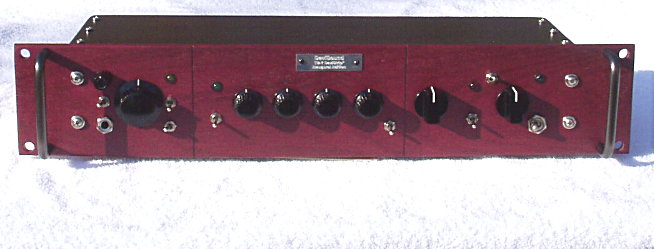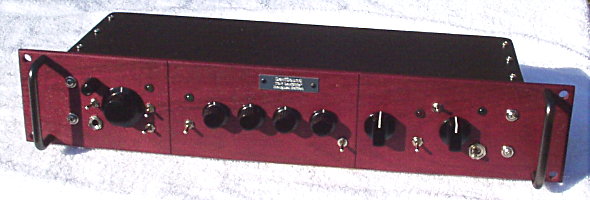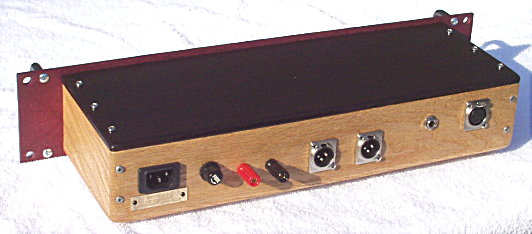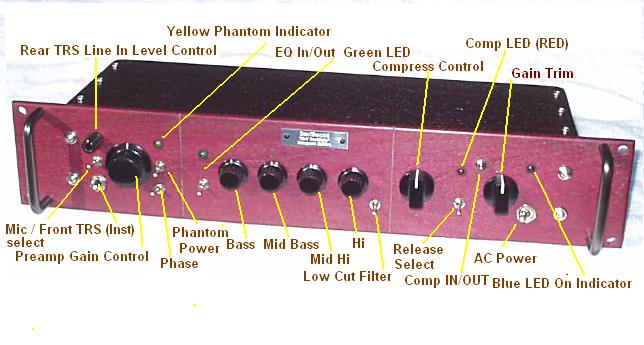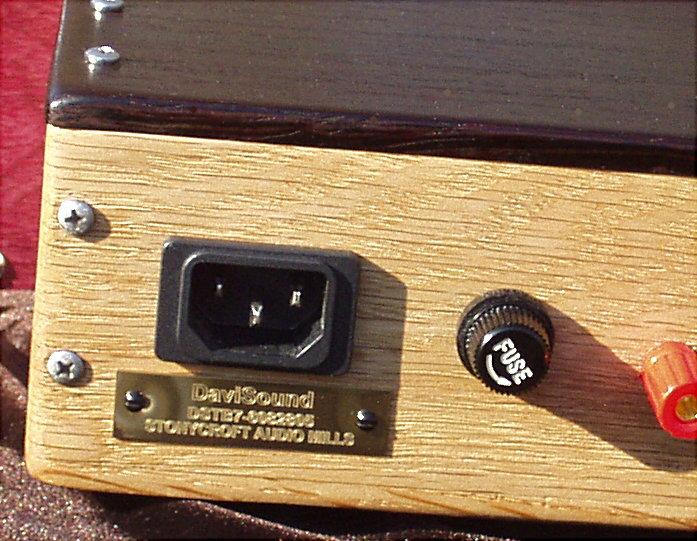The Long awaited "DaviStrip" now provides several of our most sought after audio tools in one convenient package for the serious amateur recordist, project studio owner or professional remote recording / broadcasting media. DaviSound TB-7
"DaviStrip"
Single Channel Multi-Processor
Copyrights 1998-2008, 2010 © by DaviSound
The TB-7 "DaviStrip" Revised and Re-introduced March, 2008 in Custom Cabinetry
The "DaviStrip" Package includes ... Note that the TB-7 offers DUAL Male XLR, output jacks.
- The "Mic-All" Preamp Stage with Mic / Line-Instrument Switching
- Separate Rear Panel Line input with dedicated Front Panel MIX control
- The "Musi-Q" Four Band Equalizer with associated In/Out Switch and LO-CUT Filter Switch
- The FET Version of the "DaviSmart" Compressor with Release Select Switch, In/Out Switch and Gain Trim
- Optional Remote DC Power Supply / Battery Operation capability
The TB-7 is supplied with three different knob styles for distinct visual indication of the three stages.
Actual knob stylings may vary depending on availability or client special order preferance.The illustrator model shown is client special order cabinetry ...
Purpleheart Faceplate, Wenge Top and Oak Cabinet
The various stages are presented in logical order beginning with the preamp ...
followed by the equalizer, and then the compressor / line driver stage with gain trim.
The signal flow follows this same sequence as the panel layout.
The outputs are "quasi-balanced" as per DaviSound Tool Box standards with PIN 2 HI and PIN 3 LO.However, instead of the typical 100 ohm output impedance of most standard Tool Boxes, the divided outputs of the TB-7 are isolated 600 ohms.This provision is so that a disturbance, or even a short, across the load of one output will have negligible, or no, affect on the other output. This is a highly desirable feature for live remotes!
These multiple output feeds are provided as a convenience for remote broadcast and recording as well as for use as a main/monitor, or similar applications, in-house.
For unbalanced operation from the XLR outputs, use only PIN 2 (IGNORE PIN 3) and the shield which, for unbalanced use, should be connected as ground at both ends of the cable.
As of 2007, it was decided to begin adding remote DC power capabilities to certain, applicable Tool Box models. The new TB-7 is one of these models! To facillitate BATTERY OPERATION when required for remote, field use, THUMBSCREW TERMINALS coded red (+) and black (-) were added to the rear panel.Note that the BLACK screw terminal could also serve as a supplemental direct ground terminal where desired in rack installations.
Any user supplied battery pack with a standard DC voltage of 12 volts to 44 volts may be utilized. Naturally, headroom and maximum output capabilities are closer to specifications with the higher supply voltages. However, professional results can easily be acheived with supplies of 18 to 36 volts and most traditional condenser mics will still function properly when phantom powered within this lower voltage range as well.
While care should be taken when connecting a remote power supply since main on/off switching is by-passed in this mode, the TB-7 is internally protected against accidental power supply polarity reversal.
Please note that the front panel main on/off LED indicator (green) will light when the battery supply is connected. However, the main power switch (AC on/off) does not function when powered by remote, battery supply.
This would also be an opportune place to mention that the Main power indicator LED, on most Tool Boxes including the TB-7, does NOT turn off instantly when power is removed! There will be a decay, typically, of around thirty seconds or so. We mention this here since some users have actually thought something was "wrong" with their units because of this. Quite the contrary! This "hold function" delay is simply an indication of the superior storage capacity of the on-board power supply filter capacitors!
It is advisable to have the detachable AC power cord REMOVED whenever remote DC power is connected to the thumbscrew terminals since AC power should not be applied simultaneously with remote DC battery supplies connected to the unit!
As with all DaviSound Tool Boxes, the AC power cord IEC EMI FILTER RECEPTACLE and FUSE HOLDER are at the far left of the panel. .
The first stage of this versatile processor is the original, highly acclaimed, DaviSound "Mic-All" ©™ preamplifier.
"MIC-ALL" ™©The microphone input is by rear panel XLR input connector. All of the controls are clustered to the far left of the front panel with the MIC-ALL active gain control to the center of the cluster.
The vertically mounted on/off switch located right of the gain control is the PHANTOM POWER on/off switch with up/down operation. An adjacent yellow LED indicates phantom power on/off.
Directly below the vertically operated phantom power mini-toggle switch is a horizontal mounted mini toggle switch.
This is the phase reverse switch.The left/right toggle handle position phase reverse action of the respective phase switches is all relative, of course, but the LEFT toggle position corresponds with input pins 2 & 3 to output pins 2 & 3, whereas the RIGHT position reverses the polarity of input pins 2 & 3.
The left horizontal toggle position of the Mic/Ins switch selects the Rear XLR Microphone input for routing through the "Mic-All" preamp stage. The right position selects the front T-R-S- Instrument/line input jack for routing through the preamp stage at higher impedance, reduced gain structure. However, since the active gain stage offers proper, infinitely variable, matching to the source signal, the "DI" instrument input can also be used as an extra line input with variable gain when desired. In that case the control would need only to be "cracked" at about 8 or 9 O'Clock. Approximate gain control settings for the MIC-ALL microphone preamps, as determined by the white pointer position on the control knob, are as follows:
9 O'Clock = + 28 dB 12 O'Clock = + 48 dB 3 O'Clock = + 55 dB Full CW = + 58 dB The LINE - INSTRUMENT INPUT offers approximately 18dB LESS GAIN at each similar position of the control.
Using the front panel T-R-S line input jack as a direct injection for musical instruments offers a unique application for an instrument amp!
Instead of the typical UNBALANCED instrument inputs utilized on most preamps, the TB-7 employs a special impedance/gain adjusted version of the MIC-ALL amplifier block in its DIFFERENTIAL configuration.
This arrangement offers the extremely large low frequency Common Mode Rejection Ratio inherent to the MIC-ALL amplifier design (around 100 dB) and this results in extremely quiet instrument input operation with extremely high immunity to hum pickup!
Since the TB-7 only utilizes a single MP-2 module for the Mic/Instrument input functions, special multi-way switching was devised to select between the rear panel mic jack and the front panel line/instrument TRS jack and the latter's matching / support circuitry.
NOTE - The TRS front panel input functioning as both line buffer and instrument input is possible because the medium/high impedance of this input is perfect for terminating, or bridging, all low impedance, line-level signal sources. And, since the first stage in this switched mode operates at unity gain, the following fully variable gain stage makes for a perfect, completely variable gain, matching buffer amplifier although, for +4 dBU operating levels only very low settings will be required.
When dedicated unity gain line level routing is desired, the rear panel T/R/S jack should be used with it's associated front panel line level control. This allows line/mic mixing (or line instrument mixing as desired) or separate line level return of an effect if desired. The level control for the dedicated line input is located to the upper left of the alternate switchable preamp gain control. This line input is optimized for +4 dBU input level signals. 1 Volt RMS in will yield 1 volt at the outputs (unity gain) with the level control full CW and the output amp trim control centered at 12 O'Clock.The Instrument and Line inputs utilize T-R-S jacks to offer additional instrument cable wiring options when mating with the differential inputs and each type accepts signals from balanced or unbalanced sources.
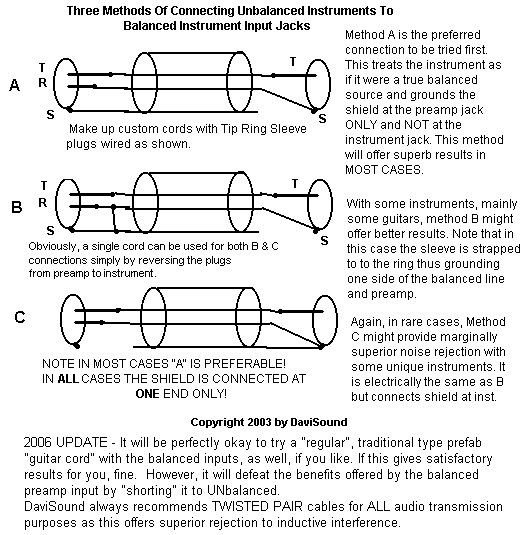
Performance "DaviSpecs" Specifications
Unless specifically stated otherwise in individual descriptions ...
and for all Tool Boxes which employ our "MP-2 MasterPiece" circuit module, which is nicknamed the "Mic-All", for the complete signal chain gain block, the electrical specifications are as follows:
FREQUENCY RESPONSE-
ALL amplifiers feature ruler flat frequency response ...
with -3dB points at 1.6 HZ and 35 KHz (maximum gain). There is a slightly variable HF bandwidth increase as gain is actively decreased to unity or below
(flat to 70KHz at unity).This is because an active filtering configuration is employed to intentionally rolloff extreme high frequency response to minimize RF / EMI out of band interference, noise contribution, and intermodulation distortions.
DISTORTION -
Combined distortions specifications are where the DaviSound "MIC-ALL" amplifiers REALLY outperform most all others anywhere! There is virtually NO measurable distortion at any level or frequency until maximum gain settings are utilized. Even then, the measurements are near the residuals of the test instruments and barely detectable at the frequency extremes- (.008% at 20 KHZ, +55dB gain)!Under more reallistic gain settings, amplifier distortion is even lower (example: typically .001%, 1KHZ, 40dB gain ... immeasurable at gain settings below 40 db [theoretically, mathematically indicated better than .0008%] )!
This performance characteristic is responsible for claim after claim from virtually ALL awe inspired users that our preamp is the "cleanest" they have ever heard!
HEADROOM -
One of the most crucial parameters in microphone signal handling is HEADROOM. The MIC-ALL amps are relatively unsurpassed in this regard with signal handling capability right up near +32 dBU before clipping! We acheive this with our House IC and thermal protection which allows a much higher power supply voltage than most conventional designs. This provides a full 8 to 10 dB more headroom than many other professional designs on the market today!Keep in mind, that output level offered by an output boosted stage does NOT always correspond to system headroom throughout! Some other units boast an output of +36 dB, or more, that do NOT offer that headroom throughout their chain. DaviSound specs are through chain, input to output.
NOISE -
EIN Unweighted -122dB 100 ohms
Noise 20Hz to 20KHz Unweighted - 98dB
IMPEDANCE-
Actual internal impedance is 2KOhms, differentially balanced for optimum voltage transfer of all low impedance professional microphones from 50 ohms impedance to 600 ohms impedance.
